Frank's travels around Britain 2009.
Glastonbury area.

 I
know we Brits can moan at times, but on this trip, the heat & humidity sapped all
my energy!
I'd been on holiday to Egypt for several years where the heat was higher, but
the humidity was much lower, here in Glastonbury though, the clinging humidity
never ceased. Centring my stay in Glastonbury's Travel Lodge was also doing it the hard way.
It is run by lovely staff and it is just outside of the town centre, but as it was 30c
outside and with the lodge being on a small industrial site next to a garage, the option
of whether to die of suffocation or open the windows & let noise make sleep an optional
extra was a big problem. I know motels started in America but in America, air
conditioning is standard. A nice modern lodge with a lift, but Travel lodge
don't go & throw their money on helping customers survive the occasional hot day
(or week in this case). Travel Lodges are very good, equipped to a price but if
you can't take a joke, you shouldn't go!
I
know we Brits can moan at times, but on this trip, the heat & humidity sapped all
my energy!
I'd been on holiday to Egypt for several years where the heat was higher, but
the humidity was much lower, here in Glastonbury though, the clinging humidity
never ceased. Centring my stay in Glastonbury's Travel Lodge was also doing it the hard way.
It is run by lovely staff and it is just outside of the town centre, but as it was 30c
outside and with the lodge being on a small industrial site next to a garage, the option
of whether to die of suffocation or open the windows & let noise make sleep an optional
extra was a big problem. I know motels started in America but in America, air
conditioning is standard. A nice modern lodge with a lift, but Travel lodge
don't go & throw their money on helping customers survive the occasional hot day
(or week in this case). Travel Lodges are very good, equipped to a price but if
you can't take a joke, you shouldn't go!
I could see the town was still stuffed with music fans who worn their festival mud with pride. A lot must have no work to bother them or is it the magnet that is Glastonbury simply attracts them. They were everywhere, equally zapped by the heat & humidity. My last trip there was a joy & I thought about climbing the hill outside the lodge to get good pictures of the Tor & town below it ... then I thought a heart attack wasn't worth the effort. I thought about doing it in the early morning or later at night, the heat stayed & I just carried on thinking about it. Much of the area was covered in a veil of clouds & there was very little wind & the humidity must have been above 80% all the time, it just drained all my resources.
 Wonderfully, my replacement for the ever faithful Sirion, an 03 Toyota Yaris was
the saviour! At last, the air con I so desired became a necessity! The excellent
build quality, very good mpg & the magic that is central locking proved its
worth. Miles at minimum cost & maximum comfort. It was a joy! To be honest,
because of the car, I drove too much & suffered the heat as little as I could. I
ate in The Tesco's in Yeovil for two reasons, one its value for money & two,
they have air conditioning ... just like the car!
Wonderfully, my replacement for the ever faithful Sirion, an 03 Toyota Yaris was
the saviour! At last, the air con I so desired became a necessity! The excellent
build quality, very good mpg & the magic that is central locking proved its
worth. Miles at minimum cost & maximum comfort. It was a joy! To be honest,
because of the car, I drove too much & suffered the heat as little as I could. I
ate in The Tesco's in Yeovil for two reasons, one its value for money & two,
they have air conditioning ... just like the car!
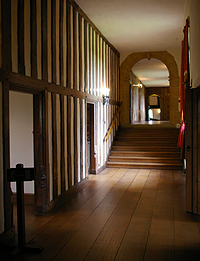 I did my usual scan of local places & first found the manor house that stands at
Barrington Court. It is believed to have been completed by 1560, although there
is evidence that this was by no means the first house to stand in its place - in
fact the site was recorded in the Domesday Book. Lots of it's history seems very
vague or just lost. At one time it was little more than a cattle shed! In the 1920s
the Lyle family (the sugar people of Tate & Lyle fame) had the house. The
architect J Edwin Forbes suggested the property to Colonel Arthur Lyle as an
ideal place to house his vast collection of wooden panelling and other
decorative items. He and his wife turned the house around and refurbished the
court house and renovated Strode House (built by William Strode in the 1600s)
which was originally a stable and coach block. It was at this time that the
Lyles contracted Gertrude Jekyll to design the three formal gardens on the
property that are kept in beautiful condition by the head gardener & staff. Barrington
Court was occupied by a tenant, Stuart Interiors, who took the lease in 1986
from Andrew Lyle, grandson of Col. Lyle but they
left in December 2008. So now you have an empty shell & your able to photograph
inside. (Not a lot of point, but better than the usual notice forbidding the use
of cameras).
I did my usual scan of local places & first found the manor house that stands at
Barrington Court. It is believed to have been completed by 1560, although there
is evidence that this was by no means the first house to stand in its place - in
fact the site was recorded in the Domesday Book. Lots of it's history seems very
vague or just lost. At one time it was little more than a cattle shed! In the 1920s
the Lyle family (the sugar people of Tate & Lyle fame) had the house. The
architect J Edwin Forbes suggested the property to Colonel Arthur Lyle as an
ideal place to house his vast collection of wooden panelling and other
decorative items. He and his wife turned the house around and refurbished the
court house and renovated Strode House (built by William Strode in the 1600s)
which was originally a stable and coach block. It was at this time that the
Lyles contracted Gertrude Jekyll to design the three formal gardens on the
property that are kept in beautiful condition by the head gardener & staff. Barrington
Court was occupied by a tenant, Stuart Interiors, who took the lease in 1986
from Andrew Lyle, grandson of Col. Lyle but they
left in December 2008. So now you have an empty shell & your able to photograph
inside. (Not a lot of point, but better than the usual notice forbidding the use
of cameras).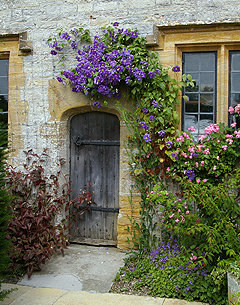
A much more attractive Manor is not far away at Lytes Cary. A house on a human scale that is a delight to walk round. In the scorching heat I needed lots of stops & the services of the small food & drink outfit that provided a good, if limited service. According to Wikipedia, The unusual name derives from the Lyte family who lived at Lytes Cary for over four centuries, and the River Cary which flows nearby. The first documentary evidence is from 1285 when it was known as Kari. William le Lyte was a feudal tenant of the estate in 1286, and the Lyte family occupied and added to the house until the mid 1700s. The earliest surviving part of the manor and associated buildings is the chapel, which dates to the mid-fourteenth century. Without doubt it is lovely. The gardens are a joy & round every corner, there is something else to please the eye.
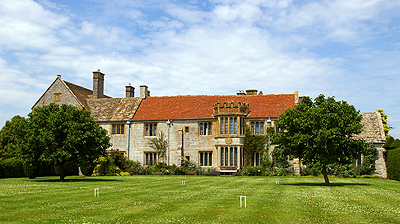 In 1907 Sir Walter Jenner – son of the late Sir William Jenner, physician to
Queen Victoria – purchased Lytes Cary. He set about restoring it and decorating
the interiors in period style, including fine 17th-century and 18th-century oak
furniture, antique tapestries and fabrics modelled after medieval textiles. He
had the west range rebuilt by the architect C. E. Ponting in a plain William and
Mary style, but left the historic core of the house mostly untouched. Jenner
left the manor to the National Trust after he died in 1948. The house and chapel
are built of the local blue lias stone. Parts of the house have mellow
honey-coloured Ham stone dressings, especially around windows and at quoins; the
later eighteenth century additions have brick dressings. The roofs are stone
tiled with some later terracotta tiles.
In 1907 Sir Walter Jenner – son of the late Sir William Jenner, physician to
Queen Victoria – purchased Lytes Cary. He set about restoring it and decorating
the interiors in period style, including fine 17th-century and 18th-century oak
furniture, antique tapestries and fabrics modelled after medieval textiles. He
had the west range rebuilt by the architect C. E. Ponting in a plain William and
Mary style, but left the historic core of the house mostly untouched. Jenner
left the manor to the National Trust after he died in 1948. The house and chapel
are built of the local blue lias stone. Parts of the house have mellow
honey-coloured Ham stone dressings, especially around windows and at quoins; the
later eighteenth century additions have brick dressings. The roofs are stone
tiled with some later terracotta tiles.
The chapel predates the existing house, and functioned as a chantry chapel, where masses could be said for the souls of the family, both living and dead. It was built by Peter Lyte in about 1343, and was completed by 1358, and would have served both the original manor which now no longer survives and later the existing house. It has a small window, or squint, that permitted servants and others to observe communion from the house. The chapel was thoroughly renovated in 1631 by Thomas Lyte, who installed the arch-braced-collar truss roof, the communion rail, a rear screen and a frieze below the roof painted with the arms of the Lytes and their relations. A monument to the south of the altar records Thomas' work on the chapel. In 1912 Sir Walter Jenner added the stained glass, including medieval glass said to have come from Charlton Mackrell church which William Le Lyte had commissioned before his death in 1316. The BBC has a very good 360o view that is definitely worth looking at. There is a link below.
 On every trip, I manage to make a mistake & this one was revisiting somewhere!
On every trip, I manage to make a mistake & this one was revisiting somewhere!
The last time I visited Stourhead it was raining badly & so I thought I'd see it
again in glorious sunshine. Well in the middle of this summer, Stourhead lake
was covered in green algae & the rest of the garden is 3000 more shades of green!
I guess I expecting summer colours, as the garden is famous for it's
rhododendrons. Was I just too early? Set in a steep-sided combe the garden
falls away to the west. My disappointment was probably due to me expecting one
thing & getting another as Stourhead is pre-eminent among English landscape
gardens. Horace Walpole described it in 1762 as, 'one of the most picturesque
scenes in the world'. At least I
didn't have a heart attack walking in the heat, plus I found a very attractive
grotto, the lair of the River God, I'd obviously missed last time.

The Stourton family had lived in the Stourhead estate for 700 years when they sold it to Henry Hoare I, son of wealthy banker Sir Richard Hoare in 1717. The original manor house was demolished and a new house, one of the first of its kind, was designed by Colen Campbell and built by Nathaniel Ireson between 1720 and 1724. Over the next 200 years the Hoare family collected many heirlooms, including a large library and art collection. In 1901 the house was gutted by fire. (you wouldn't believe how many historic homes have been decimated by fire). However, many of the heirlooms were saved, and the house rebuilt in a near identical style. The last Hoare family member to own the property, Henry Hugh Arthur Hoare, gave the Stourhead house and gardens to the National Trust in 1946, one year before his death.
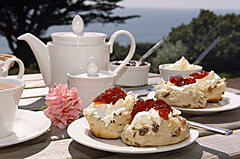 As
I love the West Country & all it has to offer, a visit would not be complete
without partaking in that quintessential English custom of "A Cream Tea".
As
I love the West Country & all it has to offer, a visit would not be complete
without partaking in that quintessential English custom of "A Cream Tea".
Oh what joy! A thousand calories a bite, a heart attack on every plate! You can go to M & S & buy their clotted cream & attempt to make it at home, but nothing compares with sitting in an English garden cafe, fresh scones, red jam & clotted cream so stiff, you may break the scone applying it. Can I recommend practise? The more you do it, the more skilled you become and if your going to die of anything, this is the way to go. I also have the demented theory that one cream tea has enough calories for the entire day, so just one is the perfect diet (so long as you eat nothing else! OK, I told you it was demented).
For the perfectionists amongst you, I have to recommend the best location is Devon. Cornwall, Somerset, Dorset & Wiltshire are right up there, but Devon just has the edge!
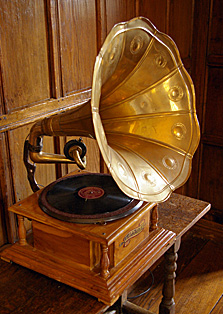
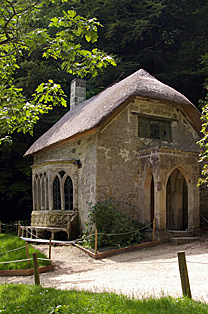
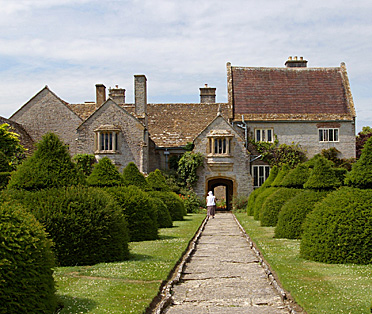


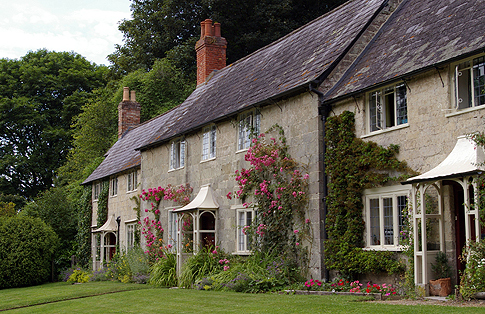
Links for information on this page:
Barrington Court early history
